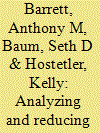| Srl | Item |
| 1 |
ID:
124855


|
|
|
|
|
| Publication |
2013.
|
| Summary/Abstract |
This article develops a mathematical modeling framework using fault trees and Poisson processes for analyzing the risks of inadvertent nuclear war from U.S. or Russian misinterpretation of false alarms in early warning systems, and for assessing the potential value of options to reduce the risks of inadvertent nuclear war. The model also uses publicly available information on early warning systems, near-miss incidents, and other factors to estimate probabilities of a U.S.-Russia crisis, the rates of false alarms, and the probabilities that leaders will launch missiles in response to a false alarm. The article discusses results, uncertainties, limitations, and policy implications.
|
|
|
|
|
|
|
|
|
|
|
|
|
|
|
|
| 2 |
ID:
136878


|
|
|
|
|
| Summary/Abstract |
A new line of nuclear winter research shows that even small, regional nuclear wars could have catastrophic global consequences. However, major disarmament to avoid nuclear winter goes against the reasons nuclear weapon states have for keeping their weapons in the first place, in particular deterrence. To reconcile these conflicting aims, this paper develops the concept of winter-safe deterrence, defined as military force capable of meeting the deterrence goals of today's nuclear weapon states without risking catastrophic nuclear winter. This paper analyses nuclear winter risk, finding a winter-safe limit of about 50 nuclear weapons total worldwide. This paper then evaluates a variety of candidate weapons for winter-safe deterrence. Non-contagious biological weapons (such as anthrax or ricin), neutron bombs detonated at altitude, and nuclear electromagnetic weapons show the most promise. Each weapon has downsides, and the paper's analysis is only tentative, but winter-safe deterrence does appear both feasible and desirable given the urgency of nuclear winter risk.
|
|
|
|
|
|
|
|
|
|
|
|
|
|
|
|